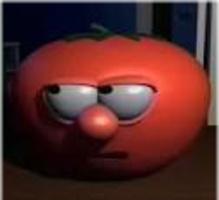
Round. Red. Good in salads and great on a BLT. Tomatoes are a typical find in the kitchens of families in the United States, so popular we are the world’s third largest producer of them.
Though some people like to engage in the “tuh-MAY-toh” versus “tuh-MAH-toh” debate, the more popular question when it comes to tomatoes has to do with their classification. Are the circular plants vegetables or fruits?
We're going to answer that once and for all. Maybe. Because science, history, and law create a lot of confusion.
A fruit is botanically defined as the mature, seed-carrying ovary (that's right) of a flowering plant. By this definition, dandelion puffs and samaras (the little “helicopter” seeds that whistle down from maple trees in the fall) are also classifiable as fruits. A vegetable is more broadly defined as the edible portion of an herbaceous plant that does not happen to be a fruit, i.e. its leaves (spinach) or roots (carrots). So, scientifically speaking, as the seed-bearing products of tomato plants, tomatoes are fruits.
When one turns to history and the law, however, a different answer emerges.
In 1886, a shipment of tomatoes for John Nix & Co, a large fruit commission based in New York City, arrived at the Port of New York from somewhere in the West Indies. Just three years prior, President Chester A. Arthur had signed the Tariff Act of March 3, 1883, requiring that all imported vegetables, but not fruits, be taxed. In accordance with the Tariff Act, Edward Hedden, the resident customs official at the time, levied a ten percent tax on the import of tomatoes and demanded that it be paid.
Arguing that tomatoes were fruits, John Nix & Co objected to the tax, sued Hedden and the Nix v. Hedden case eventually made its way to the nation’s highest court in 1893. During the Supreme Court trial, definitions of the words “vegetable” and “fruit” from three different dictionaries were entered into evidence. Definitions of other foods, including “turnip,” “cauliflower,” “eggplant” and “bean” were also read in court.
Two individuals who had been in the business of selling produce for thirty years were called as witnesses and asked to determine whether the defined words had “any special meaning in trade or commerce” that differed from their definitions. Neither witness made note of any such special meaning.
The Court decided unanimously in Hedden’s favor, ruling that tomatoes be classified as vegetables under customs regulations, based on public perception and their typical culinary uses. This fell in line with the outcome of the 1889 Robertson v. Salomon case, in which the same court ruled that beans be classified as vegetables and not seeds, for similar reasons.

“Botanically speaking,” wrote Justice Horace Gray in his 1893 opinion, “tomatoes are the fruit of a vine, just as are cucumbers, squashes, beans and peas. But in the common language of the people, whether sellers or consumers of provisions, all these are vegetables...usually served at dinner in, with or after the soup, fish or meats which constitute the principal part of the repast, and not, like fruits generally, as dessert.”
Are tomatoes fruits or vegetables? The short answer, complex though it may be, is “yes.” But they are scientifically classified as one yet legally classified as the other, so it is up to you to decide which argument you find more compelling.



